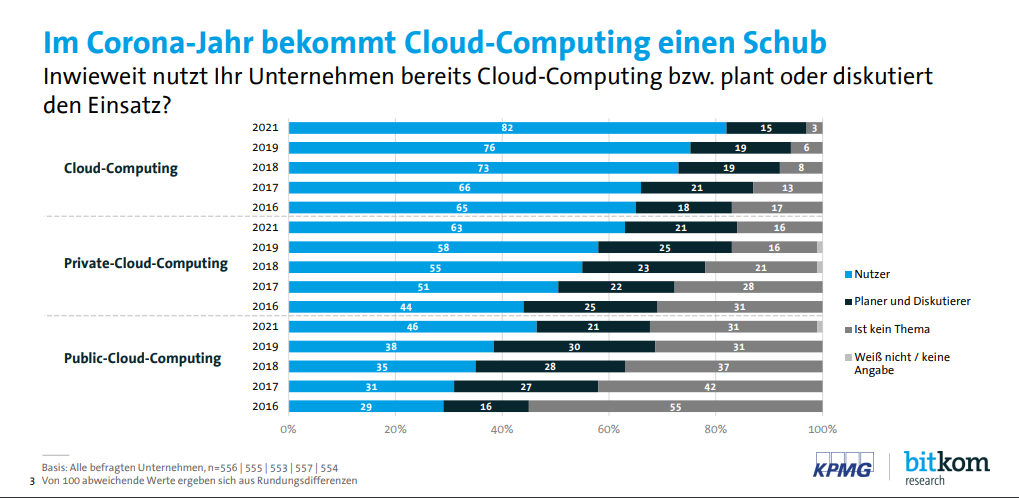What is Cloud IT – The Cloud Simply Explained
Cloud IT is by definition the term by which we generally mean classic “cloud computing”. Since as early as the 1990s, “cloud” has been a general term used to describe a central server, data storage facility or application that can be shared – usually online – without much effort. From a technical point of view, these are networked computers, usually servers, which can be accessed from numerous sources This is to be understood as an antagonist to the previously common, purely local data storage, such as a computer, which usually does not have the necessary resources to serve as a powerful data manager on a large scale. For this purpose, servers are used that can be used via interfaces (API). Obviously, the “cloud” is visualized with clouds from which collected data can be distributed to end devices.

According to the National Institute of Standards and Technology (U.S. federal agency, in English. Original “National Institute of Standards and Technology”), 5 points must be met for a technology to actually fall under “Cloud IT” or “Cloud Computing”:
- On-Demand Self Service (the self-service principle, where the user can access data in the cloud, for example, without the need for manual control or approval).
- Broad Network Access (the cloud’s services must be accessible via commercially available means accessible to any user, such as by smartphone or vehicle via the Internet).
- Resource pooling (the cloud provider undertakes to pool many resources in order to be able to serve a maximum number of users simultaneously and according to their needs. In return, the user has no influence on exactly which resources these are, i.e. application, server or database, to name examples).
- Rapid elasticity (cloud performance can be scaled up and down by the provider, often giving users the impression of unlimited performance)
- Measured Service (the services provided are statistically recorded and evaluated)
Cloud IT thus offers a wide variety of services, from infrastructure as a service (IaaS) to platform (PaaS), software (SaaS) and functions (FaaS), centrally and on demand. Thus, the cloud is considered the most important step towards digitization, as business services can now be controlled and managed centrally and scaled up as needed. This can be especially important during peak loads, since in the event of the sudden sending or receiving of a large amount of data, the load can be distributed among the numerous computers or servers in the cloud network. This means that there is no overloading of individual systems, which helps to prevent impairments or even failures.
Why Cloud Computing? The advantages of cloud IT
The practical benefits of cloud computing are obvious. If you think away from the purely private sphere, where it is often very useful if data from photos to calendars can be shared centrally and used by all members, you quickly end up with companies for which the central provision of data can be the core of the range of services. You inevitably end up in the automotive sector, where the vehicle is more than ever a rolling device, a smartphone on a grand scale that not only accesses entertainment online, but also elementary vehicle functions. Vehicle data can be read and interpreted (we recommend our article on “IDS – Identity Storage”, in which we explain the underlying technology in more detail), services can be booked, and updates can be transmitted and installed “over the air”. The coming standardization of ECUs here (we have great information for you on this, too, in the form of an exciting interview with CARIAD ) in conjunction with centralized data management on the cloud side will bring enormous developments with potentially high savings at the same time.
In any case, we are talking about data exchange in gigantic quantities, with thousands of requests per second, increasing and decreasing with high and low user frequency. For example, vehicles in large cities are used much more during rush hour than at night – a cloud system must be able to respond flexibly to this, and this is just one simple example of use among many. A high-frequency online store may have many times more online inquiries during the holiday season than in mid-summer. A cloud computing network must also be ready for this in a failsafe manner, without providing and billing for unnecessary resources during low-frequency periods.
Last, but not least, another advantage is obvious: There is no need to build and maintain your own expensive IT and manage all services on your own computing capacity. These can be rented externally without any problems; the structure and exact function of the cloud are irrelevant depending on the use. Of course, certain models of cloud usage may require a high level of knowledge about the systems being used, but fundamentally the concept of cloud computing does not depend on the technical detail behind it.
By the way, it’s not just us, i.e. the Mobility Rockstars as part of Cognizant Mobility, who see it that way: over 82 percent of all companies surveyed in Germany rely on cloud computing in their own operations, according to a study conducted by Bitkom on behalf of KPMG.

However, the list of benefits is much longer – we list a few below for your review:
- Accessibility from anywhere with Internet access
- Optionality – many possibilities to use storage according to the company’s requirements (keywords public cloud, private cloud, hybrid cloud
- Control (“As-A-Service” options)
- Data backup outside the company
- Management, protection and repairs by cloud providers
- Security features(encryption process at the highest level)
- Savings potential (no need for own hardware and resources)
- Fast scalability thanks to virtually unlimited resources
- Rapid implementation of innovations, accompanied by a competitive advantage
- Management of partly massive amounts of data possible (Big Data)
In the automotive sector, the advantages of cloud computing are even becoming an indispensable part of further development. Today’s vehicle, and even more so tomorrow’s, is a networked automobile. Millions of data from millions of users want to be processed, which is impossible for local IT. Here, only cloud computing can enable the management of these mountains of data. Companies like Volkswagen are investing high double-digit billions in the coming years to drive forward the networking of the automotive industry. From intelligent navigation systems to automatic parking, emergency assistance, autonomous driving and many more services: a future without cloud computing is impossible from the automotive sector, and a migration of local infrastructure to the cloud is inevitable. In one of our popular Mobility Rockstars interviews with Tobias Müller, Head of Cloud IT at Cognizant Mobility GmbH, we explain to all interested parties how the migration of an IT succeeds and how the dreaded “cloud lock-in” can be avoided in the process.
What is certain is that developments such as the Internet of Things (IoT), voice recognition, blockchain, data lake applications or artificial intelligence are firmly interwoven with cloud computing, so the future definitely lies in the use of and migration to the cloud.
How can I use cloud IT in my company? What services are available?
You can basically deduce how your company can benefit from cloud IT from the multitude of advantages that cloud computing brings with it. Whether it’s greater reliability or cost reduction, scalability or better distribution of resources: if you want to remain future-proof, migrating IT to the cloud is hardly avoidable. However, there are one or two things to keep in mind.
First of all, the clear definition of your own requirements and your wishes is in the foreground. For this, it is advisable to seek advice from specialists with experience and knowledge of your situation. Reputable companies usually offer an initial assessment free of charge. Cognizant Mobility GmbH is also available for such consulting.
As a small checklist, we give you the following 5 points that you should definitely consider before choosing a provider:
- Can the cloud IT provider implement everything the company needs, now and in the future? And is a later switch to another cloud possible (lock-in effect!)
- Can the company’s processes be adapted so that a cloud can be integrated, and are the investment and benefits in a healthy relationship?
- Are compliance and security taken into account( after all,according to Cloud Monitor, the two most important criteria for almost all companies surveyed)?
- What is the guaranteed service time, how redundant is the system to prevent failures?
- Where are the servers located?
Amazon’s AWS (Amazon Web Services) and Microsoft Azure can certainly be described as market leaders, but other global players are also vying for the gigantic cloud IT market:

One of the most frequently asked questions, which this article concludes, is certainly the question of security: How secure is the cloud? According to current findings, some of which can also be seen in the cited study, the publicly usable IT cloud is more secure than in-house IT, with around 10 percent fewer incidents occurring in the cloud versus on-premises IT in the last 12 months.
Security is often not just a matter for cloud providers. Depending on the concept, companies themselves can be responsible for the runnability, protection and failover of the cloud services used. Modern encryption methods and security concepts play a major role here, which can be agreed in detail with cloud providers. These also provide wide-ranging offers themselves on request. Our experts from Cognizant Mobility will be happy to advise your company on this point as well – feel free to arrange a free initial consultation with us at any time via our contact form.





















